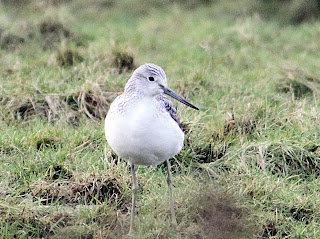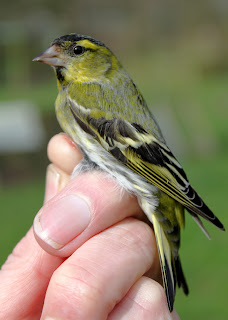After a few early mornings I was cream crackered last night so decided not to join the other lads ringing but have a little lie in followed by some gentle birding - the plans of mice and men! I hit the road at about 0730; still too early for some I thought, when the roads to Pilling seemed deserted save for the occasional budding Valentino Rossi trying desperately to take the side off my car and the knee caps off their legs.
I sought refuge in Lane Ends car park and took a walk to Pilling Water in the course of which I saw and heard my first Whimbrel of the year whistling overhead but flying south. I’m sure the bird would turn around pretty soon and head north to Iceland if more of its buddies suddenly came the other way.
I sought refuge in Lane Ends car park and took a walk to Pilling Water in the course of which I saw and heard my first Whimbrel of the year whistling overhead but flying south. I’m sure the bird would turn around pretty soon and head north to Iceland if more of its buddies suddenly came the other way.
Down at Pilling Water, I was clearly the first there as all was quiet, quiet enough for the Fluke Hall Barn Owl to be poised on a fence watching for a careless animal and even taking time out to clean its talons from a recent encounter. It flew lazily around the creek and the rough grass and perched up a few times, posts and trees a plenty.



I heard a Willow Warbler singing from the willows where the newly topped up lone crow’s nest stands out like a sore thumb. I think maybe the wildfowlers allow a nest on the principle that a pair of dominant Carrion Crow pair can control the local crow population in an environmentally friendly way. Around the creek and pool below I counted 5 Swallow that once again quickly went on their way. Then out on the marsh 3 Little Egrets, scattered far and wide with seemingly no hint of a pairsome.
There is a vibrant healthy little population of breeding birds on the stubbly set aside that surrounds the pools and old creek; 2 or more pairs of Oystercatcher, Lapwing and Redshank together with Skylark, Meadow Pipit, Greylag and the inevitable Mallard. With my traps ready I searched the Wheatear rocks for little white arses but found none, only Meadow Pipits, a straggly party of 20 or more zipping between the ditch, the fields and the sea wall. Wheatears don’t always arrive early morning, but maybe follow the sea wall from the west, only showing up at my catching spot in the afternoon; but that’s now another game plan for another day.
Destination 2 Conder Green as I gave Bank End a miss when I saw the plane scoot low over the quarry and land on Chris’ fields as the off loaded parachutes dropped towards the sea wall.
As expected, fairly quiet at CG: The brown and getting blacker Spotted Redshank, Curlew, Grey Heron, a Goldeneye pair, a Tufted Duck pair, 2 Black-tailed Godwit, 9 Teal and displaying Oystercatchers and Lapwing still to settle their business.


I got word the other day of the Starling I caught in my garden on 5th December 2009. It hadn’t travelled far – from Preesall in fact, but it was first ringed in May 2002 as a nestling. Not an amazingly old Starling, more middle aged really at 7.57 years when the UK longevity record is about 17 years and the Danish one 22 years.





































































